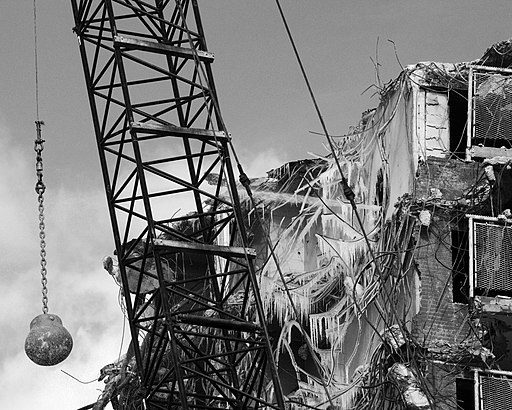DECONSTRUCTION-
TO SAVE MONEY AND RESOURCES
All materials are easier to reuse or recycle when they are sorted and separated. It’s cheaper to dispose of sorted building materials when they can be used beneficially, as opposed to sending them to the landfill.
Reusing Materials
With so many old buildings around Vermont, it’s not unusual to see a weathered barn with a slate roof kneeling by the side of the road. While pieces of buildings inevitably break, most parts can be reused repeatedly to benefit the local community. Unfortunately, usable building materials end up in landfills or incinerators every day from Construction and Demolition (C&D) projects that sacrifice conservation for speed. There are ways to conserve money and natural resources for these projects, though, such as Deconstruction and Reuse.
Deconstruction Works is a non-profit that will take apart your building piece by piece so that the most materials possible can be donated or sold, and reused for other projects. They have deconstructed entire churches, small backyard sheds, and even just interior spaces for residential and commercial customers. While their service may cost slightly more than quick demolition, the tax write off you receive from donating the materials can easily cover the extra dollars. If you have a project in mind, don’t hesitate to contact them to discuss the possibility of responsible deconstruction.

Even before breaking ground for a new structure, there is an opportunity to ensure that it doesn’t end up going to waste after its first use. The EPA offers best management practices for the design and deconstruction of buildings to prevent these materials from entering the landfill. Some ideas include creating a disassembly plan, keeping materials at standard measurements, and minimizing the use of different materials, particularly adhesives and sealants. Starting a conversation early on with the building contractor is important to incorporate these ideas into the entire process.
Recycling Materials

Other than reusing building materials, recycling them into different applications is another alternative that can conserve resources. For instance, wood can be chipped and used as fuel in biomass facilities; asphalt and concrete can be crushed and incorporated as aggregate in new pavement; gypsum board (aka sheetrock) can be recycled right back into whole pieces again. Metal is easily recycled in most areas of the country with other scrap metal. These materials must be absolutely clean with no paint, adhesive or other contaminant residue for the best recyclability.
Locally, there are two facilities that will accept concrete, asphalt and other aggregate for recycling: Markowski Construction in Florence (802.483.6469) or Wilk Paving in Center Rutland (802.438.5454). Two facilities near Burlington receive additional sorted C&D materials that are recycled: Myers C&D Recycling Facility (802-655-4312) and the All Cycle Transfer Station (802-651-5412).
According to the Construction & Demolition Association, there are over 500 million tons of usable building and road construction materials recycled annually in the United States of America. That sounds like a lot, but it is difficult to measure how much C&D materials are put in landfills or incinerated, as they often are mixed with general Municipal Solid Waste (MSW). In 2018, Vermonters disposed of about 46,823 tons of C&D materials with MSW in the landfill, which is roughly half of the total C&D debris generated (source: 2018 VT Waste Characterization Study).
